New This Week: 3 Knockout Kitchens With Natural Wood Cabinets
Whether light and breezy or rich and moody, these wood-rich kitchens might make you rethink painted cabinets
Mitchell Parker
February 2, 2018
Houzz Editorial Staff. Home design journalist writing about cool spaces, innovative trends, breaking news, industry analysis and humor.
Houzz Editorial Staff. Home design journalist writing about cool spaces, innovative... More
1. Richly Modern
Designers: Claudia Juestel of Adeeni Design Group (interior design) and Sutro Architects
Location: Healdsburg, California
Size: 200 square feet (18.6 square meters); 10 by 20 feet (about 3 by 6 meters)
Homeowners’ request. For this new-construction home, the owners wanted a “clean, modern look within a sustainable design,” says interior designer Claudia Juestel. Fewer materials and easy maintenance were additional goals.
Cabinets. Walnut. “We selected the walnut to add warmth to the cool tones of the concrete and crisp white gallery walls, and liked the beautiful figuring to soften the clean lines,” Juestel says.
Designers: Claudia Juestel of Adeeni Design Group (interior design) and Sutro Architects
Location: Healdsburg, California
Size: 200 square feet (18.6 square meters); 10 by 20 feet (about 3 by 6 meters)
Homeowners’ request. For this new-construction home, the owners wanted a “clean, modern look within a sustainable design,” says interior designer Claudia Juestel. Fewer materials and easy maintenance were additional goals.
Cabinets. Walnut. “We selected the walnut to add warmth to the cool tones of the concrete and crisp white gallery walls, and liked the beautiful figuring to soften the clean lines,” Juestel says.
Other special features. Embossed light gray concrete backsplash in the same color as the concrete countertops. Concrete floors. Custom blown-glass pendants. Stainless steel countertops on both sides of the range.
Designer secret. “Healdsburg gets very hot in the summer, and the clients wanted a serene and cool environment with very little color but that did not feel cold,” Juestel says. “So we mixed warm and cool materials, and used the fresh green of the leaves and vines in the vineyard as the fresh accent color.”
Custom countertops and backsplash: Bohemian Stoneworks; Precision collection sinks: Blanco; contemporary pull-down faucets and Parche instant hot faucet: Waterstone; Erik Buch-style stools in custom finish: Inmod; Dakar leather stool upholstery: Green Hides; custom pendant lights: Adeeni Design Group; appliances: Thermador; solid bronze T pulls in light bronze: Ashley Norton
See more of this home
Designer secret. “Healdsburg gets very hot in the summer, and the clients wanted a serene and cool environment with very little color but that did not feel cold,” Juestel says. “So we mixed warm and cool materials, and used the fresh green of the leaves and vines in the vineyard as the fresh accent color.”
Custom countertops and backsplash: Bohemian Stoneworks; Precision collection sinks: Blanco; contemporary pull-down faucets and Parche instant hot faucet: Waterstone; Erik Buch-style stools in custom finish: Inmod; Dakar leather stool upholstery: Green Hides; custom pendant lights: Adeeni Design Group; appliances: Thermador; solid bronze T pulls in light bronze: Ashley Norton
See more of this home
2. Light Contemporary
Designer: Brandon Lange of BZ Interiors
Location: Toronto
Size: 225 square feet (20.9 square meters)
Homeowners’ request. Update a small row house kitchen to include more storage, an island, a breakfast bar, modern appliances and more natural light.
Cabinets. Flat-panel rift-cut white oak with a natural stain. “We debated incorporating some white painted upper cabinets, but instead went with an all-wood look to achieve a more streamlined look,” says designer Brandon Lange.
Other special features. Antique brass handles. Bianco Carrara marble slab backsplashes and countertops. Stainless steel floating shelf above the breakfast bar to tie in with the modern stainless steel appliances. Oversize black drum pendants.
Get a guide to choosing kitchen cabinets | Find oversize black drum pendants
Designer: Brandon Lange of BZ Interiors
Location: Toronto
Size: 225 square feet (20.9 square meters)
Homeowners’ request. Update a small row house kitchen to include more storage, an island, a breakfast bar, modern appliances and more natural light.
Cabinets. Flat-panel rift-cut white oak with a natural stain. “We debated incorporating some white painted upper cabinets, but instead went with an all-wood look to achieve a more streamlined look,” says designer Brandon Lange.
Other special features. Antique brass handles. Bianco Carrara marble slab backsplashes and countertops. Stainless steel floating shelf above the breakfast bar to tie in with the modern stainless steel appliances. Oversize black drum pendants.
Get a guide to choosing kitchen cabinets | Find oversize black drum pendants
Designer secret. “The biggest thing we did to improve the space was include the patio doors at the back,” Lange says. “Otherwise the room would have felt very dark, and the feeling of the kitchen would be totally different.”
“Uh-oh” moment. “Because this home was divided into several apartments before we began construction, and also featured a very poor addition at the back, we had a very challenging issue with two different ceiling heights, which landed directly above the kitchen,” Lange says. “Thankfully, we were able to come up with a solution involving our contractor and some engineering that allowed us to maintain one uniform ceiling height. Otherwise things would have looked very odd.”
Cabinetry: BL Woodworking; hardware: Lee Valley; countertops and backsplashes: Olympia Tile; appliances: Tasco Appliances; stainless steel shelf: Perfect Stainless; counter stools: Elte Market; pendant lights: Dainolite; find oversize black drum pendants
See more of this home
“Uh-oh” moment. “Because this home was divided into several apartments before we began construction, and also featured a very poor addition at the back, we had a very challenging issue with two different ceiling heights, which landed directly above the kitchen,” Lange says. “Thankfully, we were able to come up with a solution involving our contractor and some engineering that allowed us to maintain one uniform ceiling height. Otherwise things would have looked very odd.”
Cabinetry: BL Woodworking; hardware: Lee Valley; countertops and backsplashes: Olympia Tile; appliances: Tasco Appliances; stainless steel shelf: Perfect Stainless; counter stools: Elte Market; pendant lights: Dainolite; find oversize black drum pendants
See more of this home
3. Midcentury Midtone
Designer: Lisa Knemeyer Skiles of Skiles Architect
Location: Fayetteville, Arkansas
Size: 183 square feet (17 square meters)
Homeowners’ request. “The kitchen needed to be both functional and one that we would want to live in, as it’s part of the open-concept main space of the home,” says homeowner Ashley Bailey. “As someone who loves to look at the everyday as art, I wanted to be able to enjoy the Russel Wright pottery I was handed down from my grandmother and great-grandmother.”
Cabinets. Custom riff-cut white oak with a tight, straight and even vertical grain. “The warm wood tone and even pattern complemented the modern interior,” says designer Lisa Knemeyer Skiles. “The color also played well with the crisp white walls and counters.”
Other special features. Open shelves for displaying a vintage dishware collection. Green patterned tile backsplash over the range. Polished concrete floors featuring a special mixture of river gravel aggregate. White oak butcher block island countertop that drops down to table height for a main dining area. Counter-depth refrigerator. Island shelves for storing and displaying cookbooks and objects. George Nelson-designed Bubble pendant light.
Furnishings: 410 Vintage Market; Snow Storm quartz countertops: Viatera; Modern Dimensions series backsplash tile in matte white: Daltile; Angela Adams-Forms backsplash tile (over stove): Ann Sacks; butcher block: Lumber Liquidators; Vault collection sink: Kohler; Trinsic collection faucet: Delta; appliances: Viking; cabinets: Justus Cabinet Shop; project photography: Nancy Nolan Photography
See more of this home | How to Remodel Your Kitchen
More
4 Dreamy White and Wood Kitchens to Learn From
Kitchen Cabinet Color: Should You Paint or Stain?
Cabinets 101: How to Work With Cabinet Designers and Cabinetmakers
Other Resources on Houzz
Find a pro
Browse kitchen products
Designer: Lisa Knemeyer Skiles of Skiles Architect
Location: Fayetteville, Arkansas
Size: 183 square feet (17 square meters)
Homeowners’ request. “The kitchen needed to be both functional and one that we would want to live in, as it’s part of the open-concept main space of the home,” says homeowner Ashley Bailey. “As someone who loves to look at the everyday as art, I wanted to be able to enjoy the Russel Wright pottery I was handed down from my grandmother and great-grandmother.”
Cabinets. Custom riff-cut white oak with a tight, straight and even vertical grain. “The warm wood tone and even pattern complemented the modern interior,” says designer Lisa Knemeyer Skiles. “The color also played well with the crisp white walls and counters.”
Other special features. Open shelves for displaying a vintage dishware collection. Green patterned tile backsplash over the range. Polished concrete floors featuring a special mixture of river gravel aggregate. White oak butcher block island countertop that drops down to table height for a main dining area. Counter-depth refrigerator. Island shelves for storing and displaying cookbooks and objects. George Nelson-designed Bubble pendant light.
Furnishings: 410 Vintage Market; Snow Storm quartz countertops: Viatera; Modern Dimensions series backsplash tile in matte white: Daltile; Angela Adams-Forms backsplash tile (over stove): Ann Sacks; butcher block: Lumber Liquidators; Vault collection sink: Kohler; Trinsic collection faucet: Delta; appliances: Viking; cabinets: Justus Cabinet Shop; project photography: Nancy Nolan Photography
See more of this home | How to Remodel Your Kitchen
More
4 Dreamy White and Wood Kitchens to Learn From
Kitchen Cabinet Color: Should You Paint or Stain?
Cabinets 101: How to Work With Cabinet Designers and Cabinetmakers
Other Resources on Houzz
Find a pro
Browse kitchen products
Related Stories
New This Week
4 New Kitchens With Wonderful Wood Cabinets
Pros share how they used various wood species, styles, stains and details to create warm and welcoming kitchens
Full Story
Kitchen Design
Painted vs. Stained Kitchen Cabinets
By Sam Ferris
Wondering whether to go for natural wood or a painted finish for your cabinets? These pros and cons can help
Full Story
Kitchen Storage
How to Get Your Pullout Waste and Recycling Cabinets Right
By tidgboutique
Personalize your kitchen waste storage with the best bin configuration and pullout system
Full Story
Kitchen Design
25 Ideas for Kitchen Appliance Garages
Pros are modernizing appliance garages and putting them to work to keep countertops clear and gadgets organized
Full Story
Kitchen Design
Popular Cabinet Door Styles for Kitchens of All Kinds
By Shane Inman
Let our mini guide help you choose the right kitchen door style
Full Story
Kitchen Countertops
5 Countertops That Look Beautiful in a Dark Blue Kitchen
By Lucy Searle
Inky blue kitchen cabinetry is popular, but which countertops go with it? Here are 5 top options
Full Story
Kitchen Storage
Walk-In Pantries vs. Cabinet Pantries
By Sam Ferris
We explore the pros and cons of these popular kitchen storage options
Full Story
Kitchen Layouts
How to Plan the Perfect U-Shaped Kitchen
By lwkkitchens
Get the most out of this flexible layout, which works for many room shapes and sizes
Full Story
Kitchen Storage
Get the Most Out of Your Kitchen’s Undersink Area
Clever solutions can turn this awkward space into a storage workhorse for cleaning supplies and more
Full Story
New This Week
4 Stylish New Kitchens With All-Wood Cabinets
Pros share how cabinets with a natural wood finish add warmth and flair to a variety of kitchen styles
Full Story





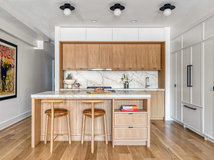
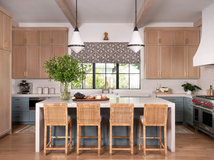


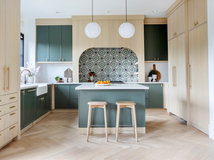
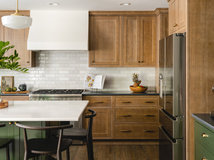





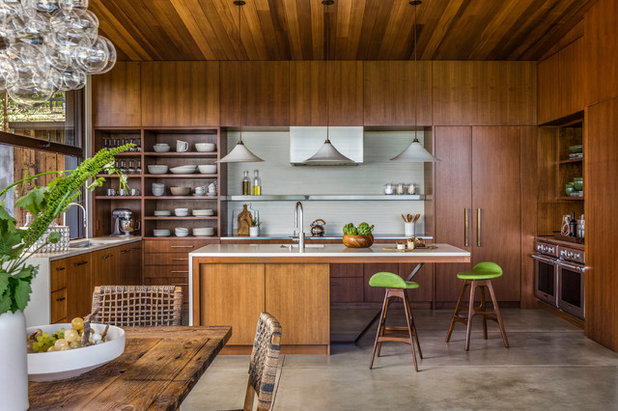
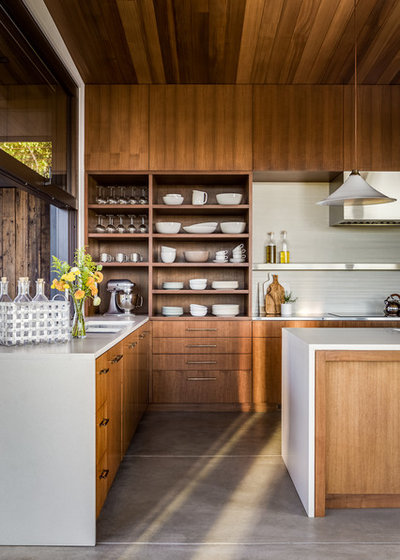
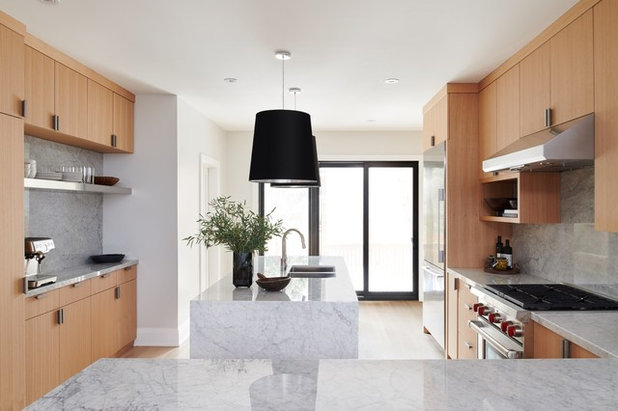
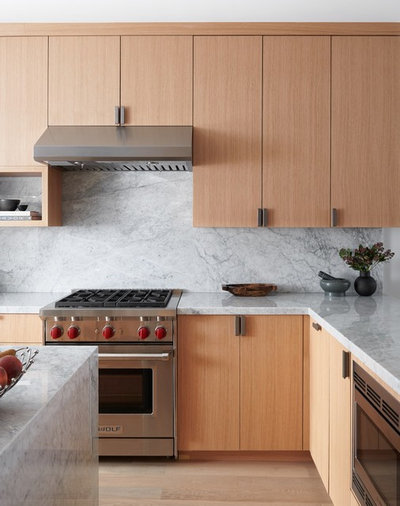
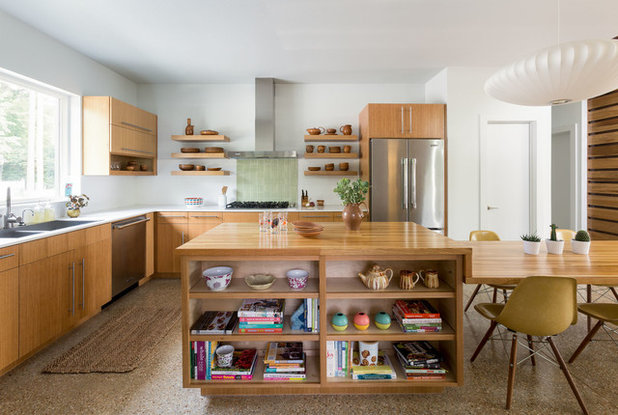






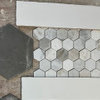
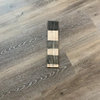
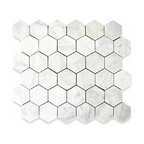
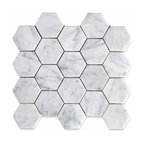
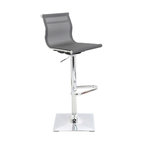
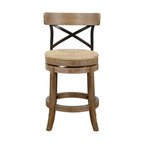

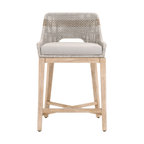
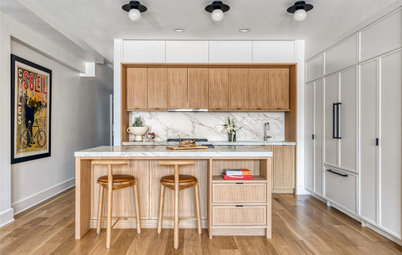
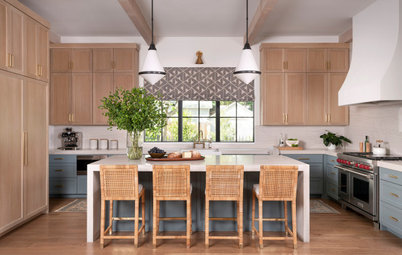
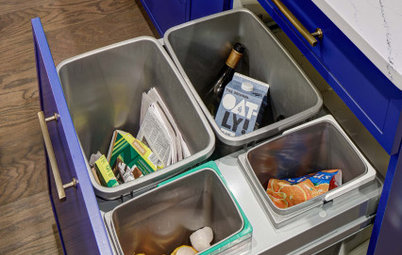
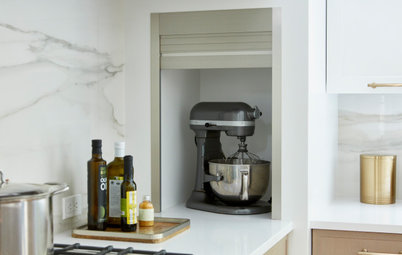
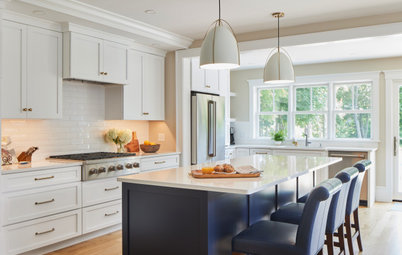
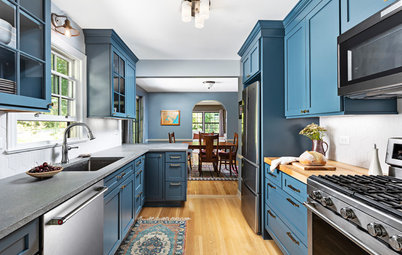
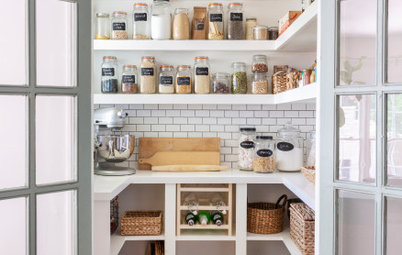
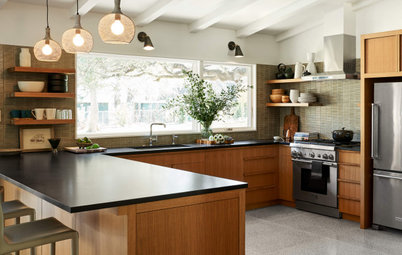
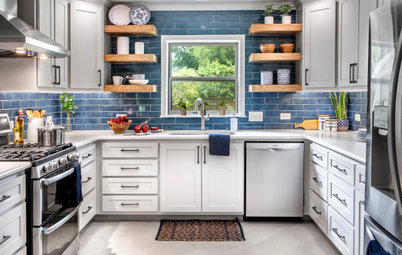
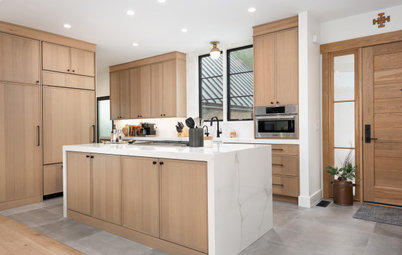
@DD, of course not. I read that the ancient poishing method used goat milk. I’m not sure what was used in the 1920s, but I owned a home that had a long flight of exterior terrrazzo steps that dated from that time, and the material was still pristine. The stairs were exposed to the elements and had seen who knows how many moving trollies thumping up and down them, over the decades, moving heavy appliances and large pieces of furniture. Yet there were no chips, cracks or signs of erosion or pitting. The gloss on the terrazzo was muted — it could have used a polishing — but both the stairs and landings were otherwise perfect.
I would think they would use silica (fine sand) to polish it and goat's milk as a finish coat - in thin coats it dries pretty clear but would not hold up to water (use a coaster!). Terrazzo has been round since ancient times in one form or another. Do you have a link for the goat milk polishing method?
Milk paint is a water based paint that anyone can make. It's been used for thousands of years. It can be made from any animal milk and lime with color pigments added. Good old borax is mixed with the casein, which is a protein in milk. The casein is also a preservative.
The goat was one of the early feral animals that became domesticated, so it figures that goat milk paint was common as a preservative finish. Cave drawings/paintings of 8000 years ago were done of milk, lime & earth pigments. King Tut's tomb had models and furniture found that were painted with milk paint. That's a long lasting paint! Very durable.
The durability (preservation) depended on the formula used. Some provided weatherproofing. Variations found included olive oil, eggs, animal glue, waxes and linseed oil. Some early 17th century painters improved the formula using warm walnut oil and lead oxide.
Today, milk paint is still used. However, one needs to be careful of the formula. New water based casein paint uses rubber and styrene aka Kem-Tone, the first latex paint. Others added lead and mercury and other solvents now known as VOCs and HAPs.
Some modern companies continue to offer Milk Paints with casein protein, lime, clay and earth pigments. It's dry, so just add water.